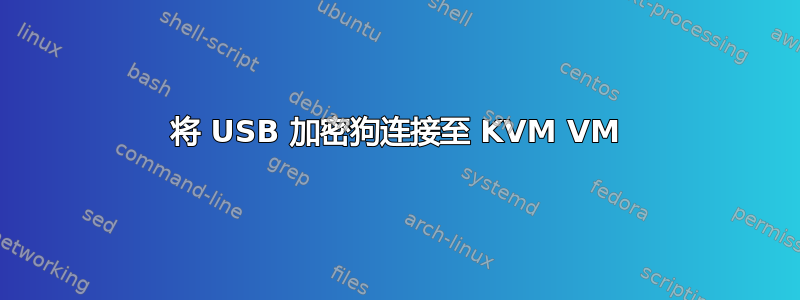
我正在努力将主机正确检测到的 USB 设备连接到 kvm vm。
我有一个新安装的 Ubuntu Server 14.10 作为 KVM/QEMU 主机。我使用以下命令设置了一个 Ubuntu 虚拟机:
virt-install --connect qemu:///system \
-n test01 \
-r 1024 \
--vcpus=2 \
--disk path=/vmstorage/01/test01.img,size=5 \
--vnc \
--noautoconsole \
--os-variant=ubuntuutopic \
--hvm \
--cdrom /path/to/ubuntu-14.10-server-i386.iso
安装成功后virsh dumpxml test01返回
<domain type='kvm' id='16'>
<name>test01</name>
<uuid>f58ca825-c999-4168-9f5a-616057d9955d</uuid>
<memory unit='KiB'>1048576</memory>
<currentMemory unit='KiB'>1048576</currentMemory>
<vcpu placement='static'>2</vcpu>
<resource>
<partition>/machine</partition>
</resource>
<os>
<type arch='x86_64' machine='pc-i440fx-utopic'>hvm</type>
<boot dev='hd'/>
</os>
<features>
<acpi/>
<apic/>
<pae/>
</features>
<cpu mode='custom' match='exact'>
<model fallback='allow'>SandyBridge</model>
</cpu>
<clock offset='utc'>
<timer name='rtc' tickpolicy='catchup'/>
<timer name='pit' tickpolicy='delay'/>
<timer name='hpet' present='no'/>
</clock>
<on_poweroff>destroy</on_poweroff>
<on_reboot>restart</on_reboot>
<on_crash>restart</on_crash>
<devices>
<emulator>/usr/bin/kvm-spice</emulator>
<disk type='file' device='disk'>
<driver name='qemu' type='raw'/>
<source file='/vmstorage/01/test01.img'/>
<backingStore/>
<target dev='vda' bus='virtio'/>
<alias name='virtio-disk0'/>
<address type='pci' domain='0x0000' bus='0x00' slot='0x05' function='0x0'/>
</disk>
<disk type='block' device='cdrom'>
<driver name='qemu' type='raw'/>
<backingStore/>
<target dev='hda' bus='ide'/>
<readonly/>
<alias name='ide0-0-0'/>
<address type='drive' controller='0' bus='0' target='0' unit='0'/>
</disk>
<controller type='usb' index='0' model='ich9-ehci1'>
<alias name='usb0'/>
<address type='pci' domain='0x0000' bus='0x00' slot='0x04' function='0x7'/>
</controller>
<controller type='usb' index='0' model='ich9-uhci1'>
<alias name='usb0'/>
<master startport='0'/>
<address type='pci' domain='0x0000' bus='0x00' slot='0x04' function='0x0' multifunction='on'/>
</controller>
<controller type='usb' index='0' model='ich9-uhci2'>
<alias name='usb0'/>
<master startport='2'/>
<address type='pci' domain='0x0000' bus='0x00' slot='0x04' function='0x1'/>
</controller>
<controller type='usb' index='0' model='ich9-uhci3'>
<alias name='usb0'/>
<master startport='4'/>
<address type='pci' domain='0x0000' bus='0x00' slot='0x04' function='0x2'/>
</controller>
<controller type='pci' index='0' model='pci-root'>
<alias name='pci.0'/>
</controller>
<controller type='ide' index='0'>
<alias name='ide0'/>
<address type='pci' domain='0x0000' bus='0x00' slot='0x01' function='0x1'/>
</controller>
<interface type='bridge'>
<mac address='52:54:00:11:b2:c1'/>
<source bridge='br0'/>
<target dev='vnet0'/>
<model type='virtio'/>
<alias name='net0'/>
<address type='pci' domain='0x0000' bus='0x00' slot='0x03' function='0x0'/>
</interface>
<serial type='pty'>
<source path='/dev/pts/0'/>
<target port='0'/>
<alias name='serial0'/>
</serial>
<console type='pty' tty='/dev/pts/0'>
<source path='/dev/pts/0'/>
<target type='serial' port='0'/>
<alias name='serial0'/>
</console>
<input type='mouse' bus='ps2'/>
<input type='keyboard' bus='ps2'/>
<graphics type='vnc' port='5900' autoport='yes' listen='0.0.0.0'>
<listen type='address' address='0.0.0.0'/>
</graphics>
<video>
<model type='cirrus' vram='9216' heads='1'/>
<alias name='video0'/>
<address type='pci' domain='0x0000' bus='0x00' slot='0x02' function='0x0'/>
</video>
<memballoon model='virtio'>
<alias name='balloon0'/>
<address type='pci' domain='0x0000' bus='0x00' slot='0x06' function='0x0'/>
</memballoon>
</devices>
<seclabel type='dynamic' model='apparmor' relabel='yes'>
<label>libvirt-f58ca825-c999-4168-9f5a-616057d9955d</label>
<imagelabel>libvirt-f58ca825-c999-4168-9f5a-616057d9955d</imagelabel>
</seclabel>
</domain>
我现在想连接一个 USB 记忆棒。经过一番谷歌搜索,我成立 一些 来源基本上都建议采取以下方法:
- 将棒连接到主机
获取供应商和产品 ID
root@host01:~# lsusb Bus 002 Device 004: ID 13fe:5100 Kingston Technology Company Inc. Flash Drive Bus 002 Device 002: ID 8087:0024 Intel Corp. Integrated Rate Matching Hub Bus 002 Device 001: ID 1d6b:0002 Linux Foundation 2.0 root hub Bus 001 Device 004: ID 0624:0249 Avocent Corp. Bus 001 Device 003: ID 0624:0248 Avocent Corp. Bus 001 Device 002: ID 8087:0024 Intel Corp. Integrated Rate Matching Hub Bus 001 Device 001: ID 1d6b:0002 Linux Foundation 2.0 root hub通过以下方式向虚拟机添加新的配置片段
virsh edit test01<devices> <!- ... -> <hostdev mode='subsystem' type='usb' managed='yes'> <source> <vendor id='0x13fe'/> <product id='0x5100'/> </source> </hostdev> </devices/>重启虚拟机
此后,虚拟机应该可以通过 看到该棒lsusb,但没有任何变化。如果我尝试将设备连接到第二个虚拟机,virsh start <othervm>则会失败error: Requested operation is not valid: USB device 002:003 is in use by driver QEMU, domain test01 但我仍然可以安装并访问主机上的存储棒。我尝试了不同的存储棒和不同的虚拟机操作系统(ubuntu 和 windows),但没有成功。
一些说明建议关闭 apparmor,但/etc/init.d/apparmor stop没有任何改变。
这让我很抓狂,因为我没有收到任何错误或日志消息,而且我不知道如何找出问题所在。关于如何将 USB 连接到虚拟机,或者至少如何进一步分析它,有什么想法吗?
答案1
这可能是访问权限的问题。您的 QEMU 守护进程无权访问 USB 设备。请尝试:
chown libvirt-qemu /dev/bus/usb/ -R
或者以任何用户身份运行 KVM。这应该可以解决问题。
答案2
要向运行虚拟机管理程序的用户授予对原始 USB 设备节点的永久访问权限,您需要创建一个 udev 规则;基于 chown 的答案只会在下次重新启动之前有效。
在 中/lib/udev/rules.d创建一个文件,如下51-usb_passthrough.rules:
SUBSYSTEM=="usb", ENV{DEVTYPE}=="usb_device", ATTRS{busnum}=="2" ATTRS{devpath}=="1" GROUP="kvm"
在这里我使用物理总线和端口号来定位设备(因为我更喜欢无论插入什么设备都通过物理端口,而不是每次连接新设备时重新配置我的虚拟机),但当然你可以使用任何你想要的属性; 该GROUP参数决定了拥有设备节点的组,这应该是运行虚拟机的任何用户。
运行udevadm control --reload-rules以使新规则立即生效(您仍然需要断开/重新连接 USB 设备)或简单地重新启动主机。
答案3
简单的解决方案:连接
nc -U socket-file
到您的 QEMU 监视器,其中 socket-file 是要监视的路径。如何查找:ps -FA | grep qemu。您将在命令行中找到它。
并在监视器上运行命令:
device_add usb-host,id=<ANY string>,hostbus=<BUS>,hostport=<PORT>
这是通过端口号传递的。您可以使用任何 VID/PID 传递任何设备。您还可以使用以下方式传递特定设备
device_add usb-host,id=<ANY string>,vendorid=0x0461,productid= 0x0010
并且它们可以插入到主机的任何端口。
还有有用的命令:
info usbhost
info usb


